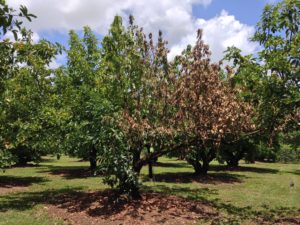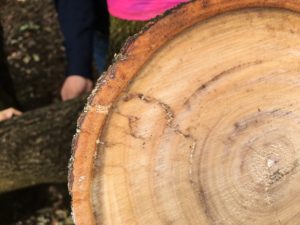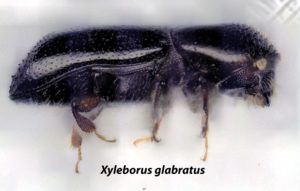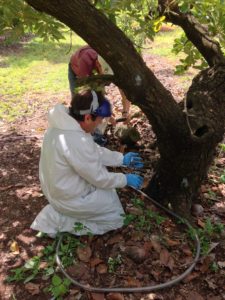Florida and California avocado growers support the research conducted by the IR-4 Project to identify controls that can slow down the spread of the devastating laurel wilt disease.
At this year’s World Avocado Congress, Dr. Timothy Spaan, who is research program director at the California Avocado Commission, reported that consumption of avocados among Americans has increased from 1.6 pounds per person per year in the early 1990s to nearly 9 pounds per person annually. Spaan said 51 percent of US households purchase avocados.
California and Florida are the largest avocado producing states. According to the National Agricultural Statistics Service, California has 47,000 acres and Florida has 5,800 acres of avocado production.

While the outlook for continued consumption of avocados by Americans looks bright, there is a dark cloud hanging over Florida growers in the form of a devastating disease called laurel wilt. The disease, which was first detected in a commercial Florida avocado grove in 2012, has been found in all of the state’s 67 counties. Researchers have estimated that as many as 120,000 avocado trees may have been lost due to the disease.
Impact of laurel wilt
Laurel wilt is caused by the fungus Raffaelea lauricola. The pathogen kills trees in the Lauraceae family, which includes avocado and several ornamental and forest species. Research has shown that some avocado cultivars, including ‘Hass,’ may be affected by the disease. While the disease has only killed avocado trees in Florida, growers in California and Puerto Rico are concerned that it could spread to their groves.
“So far the disease is only attacking and killing trees in the Lauraceae family,” said Jonathan Crane, who is professor of horticulture and tropical fruit crop specialist at the University of Florida Tropical Research & Education Center in Homestead, FL. “There are numerous native species of laurel trees throughout the US and the world. Many of those trees are forest species, but there are some trees that are sold as ornamentals, including redbay. Some of the forest trees are key food sources for specific insects and mammals that feed on either their leaves or fruit.
“The disease has already had a huge ecological effect resulting in the clear cutting the understory of some forests. Laurel wilt disease has killed over ½ billion native Lauraceae trees in the southeastern US. These are mostly swamp bay and redbay trees. The major forests that have been affected are in Georgia, South Carolina, North Carolina, and now the disease is spreading into Alabama and Arkansas. The disease has been found in 11 southeastern states.”

The only place where avocados are grown with the disease is Florida.
“Ambrosia beetles vector the disease to native trees to the north and to the west from the southeastern US,” Crane said. “Laurel wilt is now in Texas, which really isn’t that far from California and Mexico. Laurel wilt is a big threat to avocado production worldwide. It just hasn’t moved anywhere else yet to affect avocado trees in other places.”
“Scientists are speculating that the disease is going to move through the natural forest areas and end up in California and Mexico. Or someone is going to move infested wood or wood products with the beetles resulting in infestations in California, Mexico and Puerto Rico.”
Crane said one of the major ways laurel wilt can be moved to a new location is through the transport of beetle-infested wood products.
“This is the way the disease moves most quickly,” he said. “Beetle-infested wood is moved between the states and is usually transported in fire wood.”
While the fungus was initially transmitted by the redbay ambrosia beetle (Xyleborus glabratus), Crane said research has found the laurel wilt pathogen has contaminated nine other ambrosia beetle species. Two of these species have been shown to be able to transmit the pathogenic fungus to avocado trees.

“Xyleborus glabratus, which was the first ambrosia beetle suspected of transmitting the disease, is not the major beetle that attacks avocado trees,” he said. “The redbay ambrosia beetle is rarely attracted to and rarely a vector for the pathogenic fungus with avocado trees. The redbay ambrosia beetle is still spreading the pathogen throughout natural areas in the southeastern US. There are other ambrosia beetle species that are attacking the avocado trees and spreading laurel wilt.
“Ambrosia beetles are attracted to trees in the Lauraceae family. The beetles are attracted to ethanol given off by trees under stress. The stress, whether it is caused by freezing temperatures, drought, flooding, mechanical, or poor cultural practices, can cause the trees to produce ethanol. Ethanol is sort of a universal stress signal. The beetles bore into the trees and inoculate them with the fungus. The fungus grows and proliferates in the trees and then they die.”
Developing effective fungus controls
University of Florida professor emeritus and plant pathologist Randy Ploetz conducted much of the preliminary research to determine which fungicides are effective in controlling laurel wilt.
“Starting in 2006, Dr. Ploetz conducted extensive background research to identify what fungicides could potentially control laurel wilt,” Crane said. “The research was done over a period of years and included laboratory, greenhouse and field experiments. I assisted with testing the fungicides in the field. We collected preliminary data to show that the fungicide propiconazole was not toxic to avocado trees and that the fungicide was not being translocated into the fruit.
“In 2009, we approached IR-4 Project making the request to conduct the necessary trials to register propiconazole for use on avocados. At the same time, knowing how important propiconazole would be to avocado growers, with the assistance of IR-4, we also submitted to EPA a Section 18 Emergency Exemption request to allow temporary use of propiconazole on avocado in Florida.”
Kathryn Homa, Plant Pathology Coordinator at IR-4 Headquarters in Princeton, NJ, was one of the study directors for the registration of propiconazole. She wrote a Section 18 Emergency Exemption support letter. California Avocado Commission also submitted a Project Clearance Request to IR-4 to support the registration of propiconazole. This was done as a precautionary measure to ensure registration of the fungicide should the disease spread to California.
IR-4 trials were conducted in Florida, California and Puerto Rico in order for the fungicide to receive registration.
“IR-4 sent me and my technician Reed Olszack to California and Puerto Rico to help the researchers there to do the trials,” Crane said. “This happened over a three-year period. During the time the trials were conducted we repeatedly renewed the Section 18 Emergency Exemption as we worked toward registration. The field work with propiconazole demonstrated that the fungicide could protect avocado trees from laurel wilt for 12 to 18 months depending on the application methodology.”
High costs limit treatments
In order to control the fungus, propiconazole has to be delivered inside the avocado tree. Delivering the fungicide inside mature trees is very difficult because of the bark. There are two methods of delivery that were tested.

“One of the delivery methods is called infusion, which is like an IV system,” Crane said. “Propiconazole is infused into the major roots at the base of the trees. It’s a slow laborious method that takes a long time to do. The other delivery method is an injection where under pressure the propiconazole is pushed into the trees.
“Unfortunately, it is expensive to treat the trees. It costs $7-$10 to inject a tree and $13-$15 to infuse a tree. That is an expensive process if a grower has 100 trees per acre. Another disadvantage of these application methods is it’s not a one-time injection or infusion like a vaccination. The treatments have to be repeated every 12-18 months. The treatments have to be repeated because the trees metabolize the propiconazole and then they are susceptible to the disease again. Growers have to purchase the application equipment and workers have to be trained to do the treatments. The application costs make the economics of growing avocados much more difficult because the growers have to spend the money to control the disease.”
Crane said about 1,600 acres of Florida avocado trees are either being injected or infused.
“Most of the treatments are injection, about 1,200 acres,” he said. “The other 400 acres of trees are being infused.
“Avocado trees being treated with these methods are cultivars that have a higher value. Specific cultivars are worth more money so growers can afford to do the infusion or injection treatments. These are mostly late season cultivars that are harvested during late winter and early spring.”
Looking for alternative controls
Since only about 25 percent of Florida avocado growers can afford to do these treatments, Crane said researchers continue to look for alternative chemical and cultural controls.
“Dr. Ploetz determined that there are a number of fungicides that might have some efficacy against the fungus,” Crane said. “The other fungicide that we’re interested in is tebuconozole. We submitted a Project Clearance Request to IR-4 for tebuconazole. We have completed the tebuconazole studies in Florida.
“The concern is having only one fungicide to control the fungus could result in the development of resistance. We’re hoping that tebuconazole will be registered for use on avocado. We are still looking for better materials and better formulations.”
For more information:
Jonathan Crane, University of Florida, Tropical Research & Education Center, Homestead, FL 33031; (786) 217-9271; jhcr@ufl.edu.
PR# 11053 Avocado (Laurel wilt and Fusarium dieback)
PR# 10427 Avocado (American ambrosia beetle)
David Kuack is a freelance technical writer in Fort Worth, Texas; dkuack@gmail.com.
